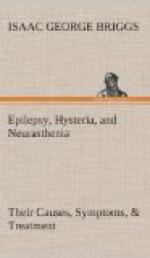* * * * *
CHAPTER II
RARER TYPES OF EPILEPSY
If it be true that: “One
half the world does not know how the other
half lives”, how true
also is it that one half the world does not know,
and does not care, what the
other half suffers.
Epilepsy shows every gradation, from symptoms which cannot be described in language, to severe grand mal. Gowers says: “The elements of an epileptic attack may be extended, and thereby be made less intense, though not less distressing. If we conceive a minor attack that is extended, and its elements protracted, with no loss of consciousness, it would be so different that its epileptic nature would not be suspected. Swiftness is an essential element of ordinary epilepsy, but this does not prevent the possibility of deliberation.”
In Serial Epilepsy, a number of attacks of grand mal follow one another, with but very brief intervals between. Serial epilepsy often ends in
Status Epilepticus, in which a series of grand mal attacks follow one another with no conscious interval. The temperature rises slowly, the pulse becomes rapid and feeble, the breathing rapid, shallow and irregular, and death usually occurs from exhaustion or heart-failure. Though not invariably fatal, the condition is so very grave that a doctor must instantly be summoned. Nearly all victims of severe, confirmed epilepsy (25 per cent of all epileptics) die in status epilepticus.
Jacksonian Epilepsy, named after Hughlings Jackson, who in 1861 traced its symptoms to their cause, is not a true epilepsy, being due to a local irritation of the cortex (the outermost layer) of the brain.
There is usually an aura before the attack, often a tingling or stabbing pain. The chief symptoms are convulsions of certain limbs or areas of the body, which, save in very severe cases, are confined to one side, and are not attended by loss of consciousness.
The irritation spreads to adjacent areas, as wavelets spread from a stone thrown into a pond, with the result that convulsions of other limbs follow in sequence, all confined to one side.
As every part of the brain is connected to every other part by “association fibres”, in very violent attacks of Jacksonian epilepsy the irritation spreads to the other side of the brain also, consciousness is lost, the convulsions become general and bilateral, and the patient presents exactly the same picture as if the attack were due to grand mal.
All degrees of violence are seen. The convulsions may consist only of a rapid trembling, or the limb or limbs may be flung about like a flail.
Jackson said: “The convulsion is a brutal development of a man’s own movements, a sudden and excessive contention of many of the patient’s familiar motions, like winking, speaking, singing, moving, etc.” These acts are learned after many attempts, and leave a memory in certain groups of brain cells; irritate those cells, and the memorized acts are performed with convulsive violence.




